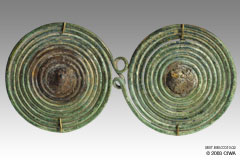Spectacle fibula, Greece, 950-800 BC

Links to other views:⇒ Larger Viewif scripting is off, click the ⇒ instead. Links to others of type FibulaCeltic bronze fibula, La Tene, 500 BCGilded bronze fibula, Byzantium, 400 AD Large gold pin, Etruria, 700-600 BC Silver pin with ibexes, Luristan, 750 BC Votive boat fibula, Etruria, 750-650 BC |
Bronze fibulae such as this one first appeared in northern Greece towards the end of the “dark ages” period of ancient Greek history that followed the destruction (around 1150 BC) of the brilliant Mycenaean civilization by brutal illiterate invaders. Although the spiral motif was not a Greek invention (it seems to have originated in northwestern Asia Minor), this particular design, with a single thread of metal wound in one direction, then the other, and its use in a large fibula, was a novelty typical of 9th-8th century northern Greece. Indeed, the appearance of several types of large fibulae at that time suggests the introduction of a new style of dress (Stearns 2002). Today, collectors call this a “spectacle fibula” because it resembles modern eyeglasses. “. . . double spiral, a widespread motive originating in Asia Minor. . . From the neighborhood of Troy it passed to the Cyclades, and then to mainland Greece” (Higgins 1981:63-64, fig.69). Parallels: Thessaloniki, Archaeological Museum “Bronze spectacle fibula from a woman's grave in the prehistoric tumuli cemetery, Vergina, second half of 9th century BC” (www.macedonian-heritage.gr/HellenicMacedonia/en/img_C115a.html). Rupert Wace Ancient Art, London “Greek Geometric bronze ‘spectacle fibula’ formed from a single wire of rhomboidal cross section into a figure of eight design. The two large and tightly twisted circular spirals are separated by a smaller figure of eight twist to the wire. One end of the wire is sharpened to form the pin, whilst the other end is bent over to form the catch. 8th Century BC. 11.7 cm” (www.rupertwace.co.uk/pages/c886_gre_bronzefibula.html). Museum of Art and Archaeology, University of Missouri-Columbia “Spectacle Fibula (Brooch). Northern Greece. Late Geometric period, ca. 700 B.C.E. Bronze” (museum.research.missouri.edu/jewelry.html). Bibliography (for this item)Black, J. Anderson1981 A History of Jewelry (republication of the 1974 book The story of Jewelry by Orbis Publishing). Park Lane, New York, NY. (24-25) Higgins, Reynold 1981 Minoan and Mycenaean Art. Oxford University Press, New York, NY. (63-64, fig 69) Marcadé, Jean 1973 Bijoux. Nagel, Geneva, Swizerland. (30, plate 33) Roaf, Michael 1990 Cultural Atlas of Mesopotamia and the Ancient Near East. Facts on File, New York, NY. ( 183) Stearns, Peter N. 2002 The Encyclopedia of World History (6th. Edition). Bartleby.com, New York. Tait, Hugh 1991 Jewelry: 7000 Years: An international History and Illustrated Survey from the Collections of the British Museum (republication of the 1987 edtion by H. N. Abrams). Abradale Press, New York, NY. (48, fig 95, fig 96 24-25, fig 12, 51, fig 108 55, fig 116) |